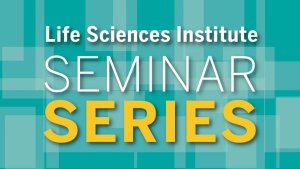Presented By: Life Sciences Institute (LSI)
LSI Seminar Series: Alan Brown, Ph.D., Harvard Medical School
Using cryo-EM to reveal the structure of the ciliary axoneme

Motile cilia (or flagella, as they are sometimes known) are responsible for the movement of many unicellular organisms including algae and protozoan parasites, and in the human body, for the swimming of sperm cells and the movement of liquids, such as mucus and cerebrospinal fluid. Defective ciliary motility can lead to male infertility and a rare genetic disorder called primary ciliary dyskinesia (PCD), where impaired mucociliary clearance leads to progressive respiratory failure. Ciliary motility is generated by the axoneme, a molecular machine so large it occupies almost the entire volume of each cilium. Each axoneme consists of geometrically complex arrangement of microtubules, ATP-powered dynein motors, and their mechanoregulatory complexes. The size and complexity of the axoneme has long impeded an atomic model, hindering efforts to understand how all the components are integrated together to orchestrate the beating of a cilium. Here I will discuss how we have utilized recent advances in cryo-electron microscopy (cryo-EM) and artificial intelligence (AI)-enabled structure prediction (AlphaFold2) to determine the 96-nm modular repeats of axonemes from Chlamydomonas reinhardtii flagella and human respiratory cilia. Our atomic models provide insights into the conservation and specialization of axonemes, the interconnectivity between dyneins and their regulators, and the mechanisms that maintain axonemal periodicity and regulate motility. Cryo-EM structures of respiratory doublet microtubules from organoids derived from individuals with PCD reveal how the loss of individual docking factors can selectively eliminate periodically repeating structures and provide a roadmap for the future of personalized structural biology.
About the Speaker:
Alan Brown, Ph.D.
Associate Professor
Department of Biological Chemistry & Molecular Pharmacology
Harvard Medical School, Boston
Dr. Alan Brown joined Harvard Medical School in fall 2017. Dr. Brown received his Ph.D. degree from the University of Cambridge in 2010 where he studied X-ray crystallography under Dr. Tom L. Blundell. He then completed a short postdoc with Dr. Matthew K. Higgins (now Professor of Molecular Parasitology at the University of Oxford) while his laboratory was located at the University of Cambridge. In 2012, he joined Dr. Venki Ramakrishnan’s group at the Medical Research Council Laboratory of Molecular Biology (MRC-LMB) as a Career Development Fellow to study ribosome structure and function by cryo-EM. Dr. Brown was named a Pew Biomedical Scholar in 2019.
About the Speaker:
Alan Brown, Ph.D.
Associate Professor
Department of Biological Chemistry & Molecular Pharmacology
Harvard Medical School, Boston
Dr. Alan Brown joined Harvard Medical School in fall 2017. Dr. Brown received his Ph.D. degree from the University of Cambridge in 2010 where he studied X-ray crystallography under Dr. Tom L. Blundell. He then completed a short postdoc with Dr. Matthew K. Higgins (now Professor of Molecular Parasitology at the University of Oxford) while his laboratory was located at the University of Cambridge. In 2012, he joined Dr. Venki Ramakrishnan’s group at the Medical Research Council Laboratory of Molecular Biology (MRC-LMB) as a Career Development Fellow to study ribosome structure and function by cryo-EM. Dr. Brown was named a Pew Biomedical Scholar in 2019.